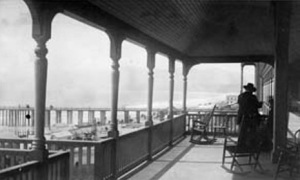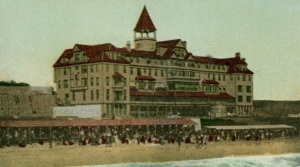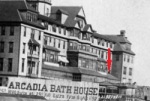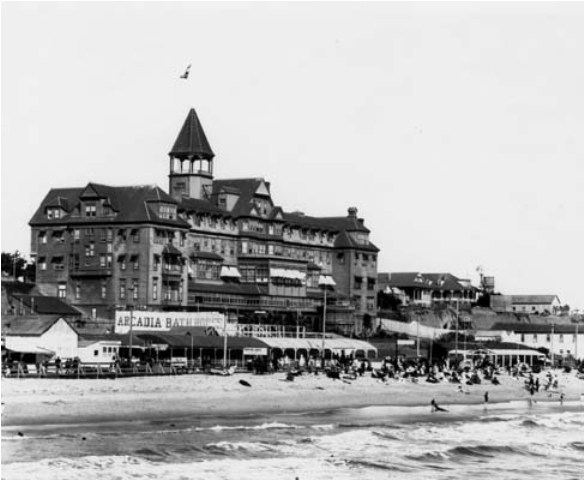When it opened with a gala ball on the evening of January 24, 1887, the elegant Hotel Arcadia became Santa Monica’s first luxury hotel and the second largest, next to Pasadena’s Raymond, in all of Southern California. Built at the then enormous cost of $65,000 and designed by the noted firm of Boring & Haas, the 200 room hostelry was dramatically sited astride a bluff with only 185 feet of white sandy beach separating it from the shimmering blue Pacific.
A product of the “Boom of the Eighties,” the Hotel Arcadia literally helped to put the seaside community on the map and provided a perfect destination for anything from an overnight excursion from the city to an entire summer or winter at the seashore. Designed for pleasure, its features included a beach level ballroom, a bowling alley, dressing rooms, children’s playroom and special hot salt water baths for those who liked their sea water steaming.  The second level was given over to servant’s rooms and storage and the third, which was the street side level, was the setting of the grand public rooms, the elegant parlors, ball room and dining rooms. Equal rights were fully in evidence at the Arcadia with a billiards room not only for the gentlemen, but also one for the ladies. Most of the public rooms on this level opened out onto a 200-foot long terrace running the length of the seaward facade. A separate glass-enclosed sun parlor was attached “where invalids can enjoy the solar rays without any wind.”
The second level was given over to servant’s rooms and storage and the third, which was the street side level, was the setting of the grand public rooms, the elegant parlors, ball room and dining rooms. Equal rights were fully in evidence at the Arcadia with a billiards room not only for the gentlemen, but also one for the ladies. Most of the public rooms on this level opened out onto a 200-foot long terrace running the length of the seaward facade. A separate glass-enclosed sun parlor was attached “where invalids can enjoy the solar rays without any wind.”
The Arcadia’s upper floors were devoted to the 120 elegant guest rooms and suites, some with private balconies, and all with either headlong views to the ocean or back across the lush ornamental gardens that made up the landward side of the property. The pinnacle of the hotel was an observation tower, offering breathtaking views in every direction a dizzying 136 feet above the beach level. A further delight for guests was a two-track gravity switchback rollercoaster, which in a one minute journey, could whisk guests either to or from the hotel and back again, all for the price of a nickel.

 For the next decade, the Arcadia was a popular and beloved West Coast destination. As Ernest Marquez wrote in his beautiful Santa Monica Beach, A Collector’s Pictorial History (Angel City Press. 2004), “Without a doubt the finest seaside hotel in Southern California, the Arcadia Hotel brought out romantic notions in guests. Postcards and letters written by Arcadia guests often made mention of the phosphorescent surf on a moonlit night, and how while listening to the hotel’s string orchestra, the water seemed to dance to the rhythm of the music.”
For the next decade, the Arcadia was a popular and beloved West Coast destination. As Ernest Marquez wrote in his beautiful Santa Monica Beach, A Collector’s Pictorial History (Angel City Press. 2004), “Without a doubt the finest seaside hotel in Southern California, the Arcadia Hotel brought out romantic notions in guests. Postcards and letters written by Arcadia guests often made mention of the phosphorescent surf on a moonlit night, and how while listening to the hotel’s string orchestra, the water seemed to dance to the rhythm of the music.”
 As Marquez further relates, “Whether a guest was from los Angeles or a long-distance visitor from the east, one thing was for certain: people fell in love with their lodgings. The Arcadia’s popularity and penchant for drawing high profile guests led the town’s first newspaper, the Santa Monica Outlook, to publish the hotel’s registry list every week.” One name that regularly appeared on that list was Colonel Griffith J. Griffith. The Welsh-born Griffith, who had made a fortune in mining, had also made quite a name for himself in Southern California real estate circles with his 1882 purchase of 4,071 acres of what had been the northern part of the historic Rancho Los Feliz and an even bigger splash when he donated 3,015 acres of that land in 1896 to the city of Los Angeles, creating the largest municipal park in the world, Griffith Park.
As Marquez further relates, “Whether a guest was from los Angeles or a long-distance visitor from the east, one thing was for certain: people fell in love with their lodgings. The Arcadia’s popularity and penchant for drawing high profile guests led the town’s first newspaper, the Santa Monica Outlook, to publish the hotel’s registry list every week.” One name that regularly appeared on that list was Colonel Griffith J. Griffith. The Welsh-born Griffith, who had made a fortune in mining, had also made quite a name for himself in Southern California real estate circles with his 1882 purchase of 4,071 acres of what had been the northern part of the historic Rancho Los Feliz and an even bigger splash when he donated 3,015 acres of that land in 1896 to the city of Los Angeles, creating the largest municipal park in the world, Griffith Park.
Even before his unprecedented donation, Griffith had fully expected to be welcomed into the upper echelons of local society. His position, he felt, was further assured by his marriage to Mary Agnes Christina Mesmer, a member of one of los Angeles’ most prominent families, the Verdugos. Griffith’s imperious behavior, however, seemed to rub people the wrong way and accounts of the day were not generally kind to the Colonel, painting him as a man of immense ego with a fiery temper exacerbated by a love of strong drink. One such observer, Harry Carr, longtime reporter for the Los Angeles Times wrote that Griffith was “the most pompous man I have ever seen. He had a strut, a gold headed cane, a flower in his buttonhole and a patronizing little snicker.”
 Although Griffith’s stunning act of civic charity did not entirely quiet his detractors, most Los Angeles citizens reacted favorably and with it, it appeared he had at last achieved his long sought-after goal of social recognition and respect. That goal, however, was forever shattered by the bizarre events that unfolded on the evening of September 3, 1903 in Suite 104-5 of the Hotel Arcadia. After spending the summer at the hotel, Griffith and his wife were beginning to make preparations to return to their Los Feliz home the following day. While Mrs. Griffith commenced packing, her husband excused himself to take in some air. According to Mrs. Griffith’s later statements, her husband soon reappeared in the suite and joined in the packing operation. What she did not know was his evening stroll had been straight into the hotel bar where he downed a number of powerful and highly intoxicating absinthe cocktails. As Mrs. Griffith later testified, “As we were packing he picked up my prayer book and came to where I was; I noticed he looked peculiarly at me as he asked me the question: ‘Would you swear on this prayer book the same as you would on a bible?'” When she replied, “Why certainly,” he ordered her to go down on her knees before him and answer three questions. “He also told me to close my eyes,” she recalled. “I then noticed the revolver which he was holding in his right hand and behind him.” Alarmed, she asked him to put the gun away, but he refused saying, “You don’t think that I would hurt you with it, do you?” He then asked if she knew anything about the recent death of Andrew
Although Griffith’s stunning act of civic charity did not entirely quiet his detractors, most Los Angeles citizens reacted favorably and with it, it appeared he had at last achieved his long sought-after goal of social recognition and respect. That goal, however, was forever shattered by the bizarre events that unfolded on the evening of September 3, 1903 in Suite 104-5 of the Hotel Arcadia. After spending the summer at the hotel, Griffith and his wife were beginning to make preparations to return to their Los Feliz home the following day. While Mrs. Griffith commenced packing, her husband excused himself to take in some air. According to Mrs. Griffith’s later statements, her husband soon reappeared in the suite and joined in the packing operation. What she did not know was his evening stroll had been straight into the hotel bar where he downed a number of powerful and highly intoxicating absinthe cocktails. As Mrs. Griffith later testified, “As we were packing he picked up my prayer book and came to where I was; I noticed he looked peculiarly at me as he asked me the question: ‘Would you swear on this prayer book the same as you would on a bible?'” When she replied, “Why certainly,” he ordered her to go down on her knees before him and answer three questions. “He also told me to close my eyes,” she recalled. “I then noticed the revolver which he was holding in his right hand and behind him.” Alarmed, she asked him to put the gun away, but he refused saying, “You don’t think that I would hurt you with it, do you?” He then asked if she knew anything about the recent death of Andrew  Briswalter and whether or not he had been poisoned. When she said she’d heard he died from blood poisoning as the result of a foot injury Griffith asked, “Have you been implicated with or do you know of anyone giving me poison?” Becoming increasingly frightened, Mrs. Griffith replied, “Why certainly not; you surely know I have not!” Griffith’s final question was “Have you always been faithful in your marriage vows?” tearfully, she declared, “As God is my judge I have and you know I have.” The words were barely out of her mouth before Griffith fired the pistol point blank into her face, the bullet hitting her left eye socket and splintering off in different directions. Staggering to her feet, dazed and covered in blood, Mrs. Griffith managed to leap towards the nearest window, falling two stories before crashing onto the veranda roof of the hotel. Miraculously, she survived both the gunshot wound and the fall and Griffith was quickly arrested for attempted murder.
Briswalter and whether or not he had been poisoned. When she said she’d heard he died from blood poisoning as the result of a foot injury Griffith asked, “Have you been implicated with or do you know of anyone giving me poison?” Becoming increasingly frightened, Mrs. Griffith replied, “Why certainly not; you surely know I have not!” Griffith’s final question was “Have you always been faithful in your marriage vows?” tearfully, she declared, “As God is my judge I have and you know I have.” The words were barely out of her mouth before Griffith fired the pistol point blank into her face, the bullet hitting her left eye socket and splintering off in different directions. Staggering to her feet, dazed and covered in blood, Mrs. Griffith managed to leap towards the nearest window, falling two stories before crashing onto the veranda roof of the hotel. Miraculously, she survived both the gunshot wound and the fall and Griffith was quickly arrested for attempted murder.
In the sensational trial that followed, Griffith’s lawyer, the brilliant Earl P. Rogers, attempted to prove his client was no would-be murderer, but a victim of “alcohol insanity.” The trial’s most dramatic moment came when former California governor Henry T. Gage, acting as prosecutor, unexpectedly threw back the veil covering Mrs. Griffith’s face revealing her horrible disfigurement to the shocked assemblage. The jury quickly convicted Griffith, but Rogers had nonetheless served his client well and Griffith was given but two years in San Quentin. After serving out his sentence, Griffith returned to Los Feliz and, amazingly, his wife, who had forgiven him and remained loyal to the end. She was at his side when he expired on July 6, 1919.
By the time of Griffith’s death, the scene of his crime, the Hotel Arcadia, had long since passed into memory. Once the showplace of the Pacific Coast, the old hotel was already past its prime by the time of the Griffith shooting, its Victorian architecture seemingly quaint and out of fashion. The end came in 1909 when the grand old hotel was demolished to make way for an exclusive residential development to be named Seaside Terrace. Today, one of its streets, Arcadia Terrace, is the only reminder of the legendary Hotel Arcadia.






I like reading about all of it. Fascinating. I especially like the fact that my great great grandfather, George Boehme, bought some of the first lots in Santa Monica and when the Arcadia Hotel no longer existed, he had some people stay at his Boehme Villas or cottages on Ocean Avenue or Boehme Block.
Absolutely fascinating read. Having grown up in Santa Monica and spending my first nine years away from “home” as a young adult in Los Feliz, I never knew any of this amazing history. Great story, great work. Thank you.
Thanks so much, Timothy! It’s a wild story, yes?